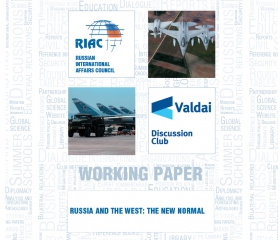Today, Russia is the only major power that is introducing significant innovations. Moscow is attempting to reduce the gap that appeared in the 1990s–2000s. Besides, given that NATO is much larger in scale, Russia uses its nuclear potential to compensate for the fact that it lags behind in the size of its conventional capabilities.
It may be said that the future of the Intermediate-Range Nuclear Forces Treaty (the INF Treaty) is assured. Moreover, should a critical situation arise, the United States is more likely to withdraw from it than Russia. The INF Treaty is beneficial for the Kremlin, since without it, the United States could deploy major medium-range missile forces in Western Europe, creating a high level of danger for Russia’s strategic nuclear weapons deployed in the European part of Russia and for the command centres, particularly for Moscow. The threat stems from short flight time, which leaves little room for decision-making. Withdrawing from the INT Treaty is disadvantageous for the Kremlin precisely because going back to the confrontation at that level will result in Russia potentially finding itself a target again, with the principal potential aggressor being across the ocean.
Theoretically, should the escalation of Russia–U.S. relations reach a critical point, the United States could withdraw from the INF Treaty and start deploying its missiles on bases it would establish in response to Russia deploying such weapons as sea-launched Kalibr cruise missiles and Iskander missiles.
Moscow has no intention of provoking NATO. Russia still has not re-armed its guided missile brigade stationed in Kaliningrad with Iskander missiles. This is a backup for a possible escalation scenario. Today, Iskander missiles periodically deployed in Kaliningrad are permanently deployed in Luga in the Leningrad region, and they are moved to Kaliningrad for military exercises or in case of an escalation.
The situation with New START (Strategic Arms Reduction Treaty) is more complicated. New START expires in a few years. Right now, we cannot say whether it will be followed by START IV and a further reduction in nuclear weapons, since it is disadvantageous for Russia in the current circumstances. Since the United States has a significantly larger number of precision-guided non-nuclear long-range weapons, further reductions could result in Russia’s nuclear potential being destroyed in an unexpected first strike and, given the current state of the missile defence systems’ development, whatever remains will be insufficient to cause unacceptable damage to the aggressor. These considerations prevent further reductions. Besides, nuclear weapons of secondary nuclear powers such as China, France and the United Kingdom also acquire a new significance. Any agreement should include other members of the nuclear club and should stipulate limitations imposed on the development of non-nuclear long-range precision weapons. At the same time, the United States bluntly refuses to discuss any possible limitations of such weapons. In 2002, Washington withdrew from the Anti-Ballistic Missile Treaty, which does not raise hopes that the United States and Russia could agree on the further nuclear weapons reduction. Therefore, we can expect New START to expire, and nuclear arsenals in Russia and the United States to increase after 2020.
As for nuclear capabilities, Iskander missiles capable of carrying a nuclear payload can be deployed in Kaliningrad. It should be kept in mind, however, that nuclear weapons are most likely to be already deployed in Kaliningrad. The Navy stationed in Kaliningrad has nuclear weapons, and the air force units in the region may carry aircraft-launched nuclear weapons. It is possible that nuclear artillery is located there too. In addition, short-range Tochka ballistic missiles that are already deployed in Kaliningrad Region could also carry nuclear payload.
The timeline for enhancing Kaliningrad’s nuclear potential depends on how relations between Russia and the West develop. If things go well, Russia might remove its Tochka missiles; if relations sour, Russia might permanently deploy Iskander missiles there. Regarding further deployment, in theory, railway-based combat rocket systems might be put back on combat duty in the near future. So far, it is not clear where they would be deployed, but it is quite possible that the infrastructure will be restored in the previous deployment locations, for instance, in Krasnoyarsk. Some sources claim that work is underway to renovate the infrastructure of land-based missile regiments in the Uzhur missile deployment area around Krasnoyarsk. Currently, R36M2 missiles, known as Voevoda, are deployed there. Plans for the near future include the deployment of the RS-28 Sarmat, clearly intended to replace Voevoda missiles, since the latest missile of that class was produced in 1992. Deploying nuclear weapons in new places is hardly likely; Russia’s principal task is to renovate its existing deployment locations.
Among the most intriguing events in military-technical cooperation are the testing of Sarmat missiles and the placement of the Barguzin railway missile train on combat duty. What is more, it is possible that Knyaz Vladimir, the fourth Project 955-class ballistic missile submarine, will be launched in 2017. Otherwise, things will continue as they are now, that is, Iskander missiles will be produced; brigades are slated to switch to these missiles. Yars ballistic missiles will also be produced. Existing data suggests that the Rubezh missile system, a lightweight version of a mobile missile, has gone into mass production. It is frequently compared with Kurier, the Soviet missile system that was in development in the 1980s, but was not put into mass production. Certainly, ship-based Bulava ballistic missiles will still be produced for the Borey-class submarines currently under construction.
In the meantime, the United States is preparing to design a new land-based intercontinental ballistic missile. Recently, Washington started to collect data from manufacturers. It is possible that an official tender will be announced in 2017, and we will learn more of what this American missile will look like. The Americans want it to replace the Minuteman ballistic missiles. Minuteman missiles are also fairly old; they were produced between 1970 and 1978 – that is a fair few years. They are regularly modernized. The United States is now considering a new ballistic missile largely due to the vague prospects of further nuclear reductions.
As for China, it is difficult to make any predictions, since this is a highly classified area, and it is hard to say what the country is going to do. The United Kingdom has started the process of building a new class of ballistic missile submarine. It is already known that the flagship will be called the Dreadnought. It is possible that the official keel laying ceremony could take place next year. It is expected to be put on combat duty 10 years after that. Nothing new is expected from France in this area. Today, Russia is the only major power that is introducing significant innovations. Moscow is attempting to reduce the gap that appeared in the 1990s–2000s. Besides, given that NATO is much larger in scale, Russia uses its nuclear potential to compensate for the fact that it lags behind in the size of its conventional capabilities.






